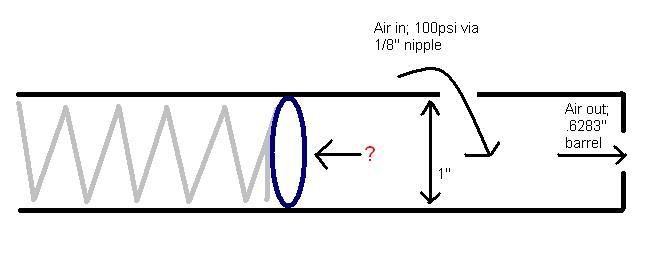Page 1 of 1
Calculating Backpressure?
Posted: Wed Nov 07, 2007 9:50 pm
by gotmilk1124

I'm building an airsoft gun with a modified piston valve, and I'm trying to figure out the pressure exerted on the spring shown in the picture by the air pressure in the chamber.
Because the air is exiting the barrel, I assume that it exerts back pressure on the piston, so how would I go about calculating that?
Posted: Wed Nov 07, 2007 10:12 pm
by spudgunnerwryyyyy
force=pressureXsurface area
do the math
Posted: Wed Nov 07, 2007 10:31 pm
by gotmilk1124
spudgunnerwryyyyy wrote:force=pressureXsurface area
do the math
Right, but the air is going to want to travel via the path of least resistance, AKA the barrel, which puts much less pressure onto the spring. If you use the P*A formula, it would put 80 lbs of pressure on the spring, which seems way too high.
Posted: Wed Nov 07, 2007 10:32 pm
by spudgunnerwryyyyy
yes but for a small time the full pressure will hit that spring resulting in pressure drop.
Posted: Thu Nov 08, 2007 12:14 am
by jackssmirkingrevenge
Since your inlet is much much smaller than the barrel, I would imagine that unless there's a projectile's in the barrel, the spring wouldn't be affected at all.
Posted: Thu Nov 08, 2007 6:22 am
by psycix
gotmilk1124 wrote:spudgunnerwryyyyy wrote:force=pressureXsurface area
do the math
Right, but the air is going to want to travel via the path of least resistance, AKA the barrel, which puts much less pressure onto the spring. If you use the P*A formula, it would put 80 lbs of pressure on the spring, which seems way too high.
Just try it!
Math can do alot, but no more than giving numbers, but trial and error will prove MUCH MORE!
Posted: Thu Nov 08, 2007 3:27 pm
by jimmy101
gotmilk1124 wrote:spudgunnerwryyyyy wrote:force=pressureXsurface area
do the math
Right, but the air is going to want to travel via the path of least resistance, AKA the barrel, which puts much less pressure onto the spring. If you use the P*A formula, it would put 80 lbs of pressure on the spring, which seems way too high.
Nope, it doesn't matter which way the air is travelling the
pressure is the same everywhere in the chamber. Therefore, the force on the spring, assuming the piston atop the spring is a reasonably air-tight fit, is the pressure times the area, like folks have said.
80 pounds of force is perfectly reasonable. The piston in a 3" diameter pneumatic valve (like a barrel sealer) will experience several hundred pounds (at least) of force when fired.
Posted: Thu Nov 08, 2007 5:57 pm
by boilingleadbath
1) Technically, the direction of flow in the chamber does matter; if it changes, you get a localized high-pressure region.
I don't expect this to be significant in this situation.
2) Air leaves through holes for a reason: pressure. And the higher the pressure, the faster it leaves.
Thus, one finds that the pressure in the chamber you've drawn a picture of will not be either zero nor equal to the inlet pressure.
However, I'm not familiar with the equations used to calculate how fast fluids flow through an orifice... so I can't give you a numerical value... my bet, though is somewhere between:
100psi / sqrt((.628/.249)<sup>2</sup>)
100psi / (.628/.249)<sup>2</sup>
(that is, between 40psi and 15psi)
Obviously, I'm pulling formulas out of my butt, but they seem halfway reasonable.
Posted: Fri Nov 09, 2007 12:25 pm
by jimmy101
boilingleadbath wrote:1) Technically, the direction of flow in the chamber does matter; if it changes, you get a localized high-pressure region.
I don't expect this to be significant in this situation.
2) Air leaves through holes for a reason: pressure. And the higher the pressure, the faster it leaves.
Thus, one finds that the pressure in the chamber you've drawn a picture of will not be either zero nor equal to the inlet pressure.
You are correct, the "1/8 inch nipple" inlet is going to introduce a pretty big pressure drop at that point.
Yes, the air flows because of a pressure gradient, no gradient then no flow. But, air flows at nearly the speed of sound, so the actual pressure gradient in the system, beyond the inlet restriction, is extremely small. The pressure gradient from the piston top to the butt of the ammo is going to be miniscule. Indeed, the gradient may be backwards, that is, the pressure on the piston will be greater than the pressure on the ammo if the ammo is moving faster than the piston.
The air also has momentum, but since the density of dry air at 120 PSIG is only about 10g/liter it's momentum is pretty small.
The peak pressure in the chamber may or may not reach the inlet pressure, it all depends on the characteristics of the system. How massive is the projectile? How much friction is there? What are the air flow characteristics through the fairly small inlet port?
From a design standpoint, the gun / piston / return spring etc. should be designed assuming the worse case scenario, the chamber reaches the inlet pressure at some point in the firing cycle.
